TESTING THE SHAOLIN WAHNAM SPARRING METHODOLGY ON BEGINNERS
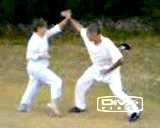
If you think kungfu cannot be used for combat, have a look at these videos
At a Shaolin Kungfu course held on 18th, 19th and 20th August 2005 in Soria in Spain, the course took only three days, with four hours of non-stop training in the morning and three hours of non-stop training in the evening each day.
Except for two young men, Lucas and Adofo, who had practiced a few years of Karate, all the other participants had no previous martial art experience. However, two of the participants, Carlos and Rosa, attended a three-day regional Taijiquan course just before the Shaolin Kungfu course. They also attended an Intensive Chi Kung Course in Malaysia in 2004.
The first day was spent on Shaolin Kungfu basics, i.e. stance training, footwork and basic Shaolin patterns. On the second day the participants applied the basic patterns for combat, and linked the patterns together into a set, “Lohan Asks the Way”. They also learned “fa-jing” or explode force, as well as kicking attacks and their defences.
Pre-arranged sparring as well as sparring with defined conditions were practiced on the third and final day. Participants also learned felling and gripping attacks and their defences, as well as linked the combat sequences into two kungfu sets, “Black Tiger Steals Heart” and “Double Dragons Embrace Moon”. The climax of the course was free sparring where the participants used typical Shaolin patterns.
The results of the course were inspiring. Not only beginning students could learn three kungfu sets in three days, they could spar reasonably well using typical kungfu techniques and skills. The following video clips show their training sessions as they were, without any pre-arrangement or editing. We hope the video clips may be of some help to kungfu practitioners who wish to find out how these beginner students could be able to spar using kungfu patterns after just three days of intensive training.
Soria 2015
Stance Training
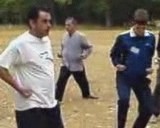
One main reason why the beginners at the course could achieve good and fast results was the emphasis placed on stance training, footwork and accurate forms. This video clip shows the participants at stance training, or “zhan zhuang”. The secret of stance training is relaxation. After standing at the stances, the participants go into chi flow and Standing Meditation.
Basic Shaolin Hand Patterns
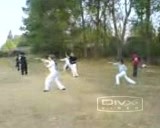
All attacks can be classified into four main categories: striking, kicking, felling and gripping. Strikes come from four main directions: top, middle, low and sides. This video shows participants practicing eight basic hand patterns which represent the four main types of strikes and their defences. The names of the patterns are “Black Tiger Steals Heart”, “Poisonous Snake Shoots Venom”, “Precious Duck Swims through Lotus”, “Hand a Golden Star”, “Single Tiger Emerges from Cave”, “Golden Dragon Plays with Water”, “False Leg Hand Sweep” and “Immortal Emerges from Cave”.
Lohan Asks the Way
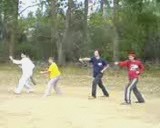
The eight basic patterns of striking attacks and defences are linked into a kungfu set called “Lohan Asks the Way”. By practicing the set students familiarize themselves with typical hand attacks and their defences.
Fa-Jing, or Explode Farce
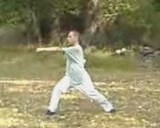
“Fa-jing”, or explode force, is a fundamental skill to channel internal force from the dan tian to the hand or any part of the body to strike an opponent. The feet should be firmly rooted to the ground, the body movement controlled by the waist, and fist spiral out from the waist. These constitute the “three external harmonies”. The movement must be fluid and relaxed, the energy flows from the dan tian to the striking point, and the mind focused on the action. These constitute the “three internal harmonies”.
Right Spacing
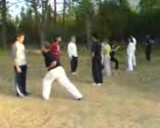
Right spacing is essential in combat. This video clip shows an effective method to develop this fundamental combat skill. The initiator moves into right spacing to implement a pre-arranged strike, while the responder observes the spacing and movement of the attacker.
Combat Sequence Practice (Part 1)
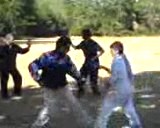
This is the first of the basic Shaolin Combat sequence for the training of combat efficiency. The initiator attacks with “Black Tiger Steads Heart”, and the responder responses with “Single Tiger Emerges from Cave”. The patterns are pre-arranged. The patterns are purposely reduced to a minimum so that the students can focus on developing combat skills, especially on right spacing, right timing and right forms.
Combat Sequence Practice (Part 2)
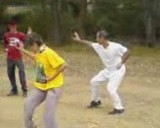
This video clip taken on the evening of the first day of the course, shows another basic Shaolin combat sequence, called “Precious Duck Swims through Lotus”. All the movements are pre-arranged. As the patterns are still new to the students, their forms are not yet accurate and their movements still slow and hesitant. But it is heartening to note that the students help one another in the training, and not try to out-do each other. Professor Inaki Rivero Urdiain, an instructor of Shaolin Wahnam Spain, purposely slows down his attack to help Lucas to learn, as well as corrects Lucas's form.
Combat Sequence Practice (Part 3)
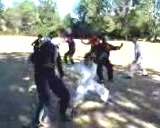
This video clip, taken impromptu on the morning of the second day, shows noticeable progress in the combat sequence training. The patterns are still pre-arranged, but as demonstrated by the two combatants in front, Lucas and Rosa, as well as by Carlos and Professor Inaki behind them, their forms are exact and their movement fluid. Nevertheless, notice that Professor Inaki freezes his left “horn punch” to enable Carlos to counter. The pair behind them, Professor Xavier and Afodo, is still hesitant in their movements, but they will soon improve as shown in later video clips.
Kicks
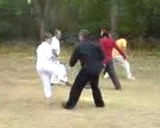
This video clip shows a later part of the training session on kicks and their counters. Compared to the earlier part, there is noticeable improvement in the skills of both the attackers and the defenders in applying and countering kicks. The foot work here is better and the movements more fluid and spontaneous. The kicking attacks here are represented by “Happy Bird Hops up Branch”, and the counters by “Lohan Strikes Drum”. These are representative kicking attacks and counters in our Shaolin Wahnam training. When one is skillful in these kicking techniques, he may progress to other types of kicks and their counters.
Felling Attacks
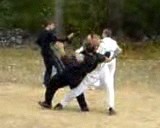
Felling an opponent is an essential part of combat. At the beginning of this video clip Professor Inaki demonstrates how to apply the pattern “Uprooting Tree with Roots” to fell an opponent backward. At first the participants are uncertain of the technique as well as not fluid with the skills, although Carlos who partners Professor Inaki does quite well. Nevertheless, with systematic practice eventually they could apply the techniques effectively towards the end of the training session (but not shown in this video).
Gripping Attacks
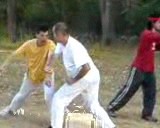
Striking, kicking, felling and gripping are the four categories of attacks. To be complete in combat efficiency, one should be able to defend against all these four categories of attacks. This video clip shows students applying gripping attacks and their defences. An opponent grips the exponent with one hand and simultaneously strikes him with the other. Depending on various ways of being gripped, the exponent responds with “Poisonous Snake Shoots Venom” or “Double Dragons Embrace Moon”. It is also noticeable from the video that there is a marked improvement in performance over that on the first day.
Free Sparring (Part 1)
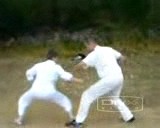
We are particular glad of the following four achievements by the participants. They could use kungfu patterns effectively for free sparring, no one was hurt, they were not tired nor panting at the end of the session, the free sparring was both enjoyable and beneficial for personal development. Our outstanding performer was Rosa, a young mother of two lovely children, who is shown in this video clip free sparring with her instructor, Professor Inaki Rivero Urdiain. Seeing how fluidly and spontaneously Rosa spars, it is difficult for some people to believe that she had no prior martial art training before this three-day Shaolin Kungfu course and another three-day Wahnam Taijiquan course just before this.
Free Sparring (Part 2)
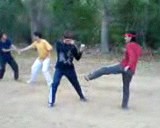
Alfodo and Lucas, beides their instructor, Sifu Inaki, were the only two persons who had some prior martial art experience, having practiced Karate for a few years. Later Lucas told us that he was amazed he had learnt more about sparring in this three-day course than in his many years of Karate. Having had a surgical operation to repair some damage sustained in his Karate free sparring, Lucas said he was particular pleased that free sparring in Shaolin Wahnam was an occasion where sparring partners helped one another and had fun, rather than punching and kicking one another in an unrestrained manner.
Free Sparring (Part 3)
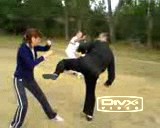
Espera and Carlos had no prior martial art experience, though Carlos also attended a three-day Wahnam Taijiquan course just before this. Expera, who also attended this course, had much difficulty on the first day, but with systematic practice which she told us that she enjoyed much, she progressed remarkably. It is obvious that Carlos purposely slows down to help Espera in the free sparring. We are very proud of Espera, who overcame initial difficulties and is able to use typical kungfu patterns for free sparring within three days.
Free Sparring (Part 4)
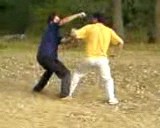
David and Professor Xavier, both of whom had no previous martial art experience, had been sparring for about half an hour, and they had been practicing other aspects of combat application continuously for another two and a half hours before that. Yet they were not panting or tired. This was possible because they had learnt and had been trained in this course to be relaxed and use chi flow in their combat application. But what is more significantly is that they had much fun and comradeship in the sparring session.
Free Sparring (Part 5)
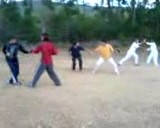
Free sparring, called “san-da” in Chinese, is an essential aspect of kungfu training. It comes at the end of a systematic combat application programme. It is logical that when one practices kungfu, he (or she) uses kungfu in his free sparring and fighting. But for some reasons, many kungfu practitioners today cannot apply their kungfu for sparring or fighting. We release this series of video clips to show how we train sparring in the hope that those who share the same idea with us, that kungfu can be used for sparring and fighting, may find them useful.
LINKS
Courses and Classes
